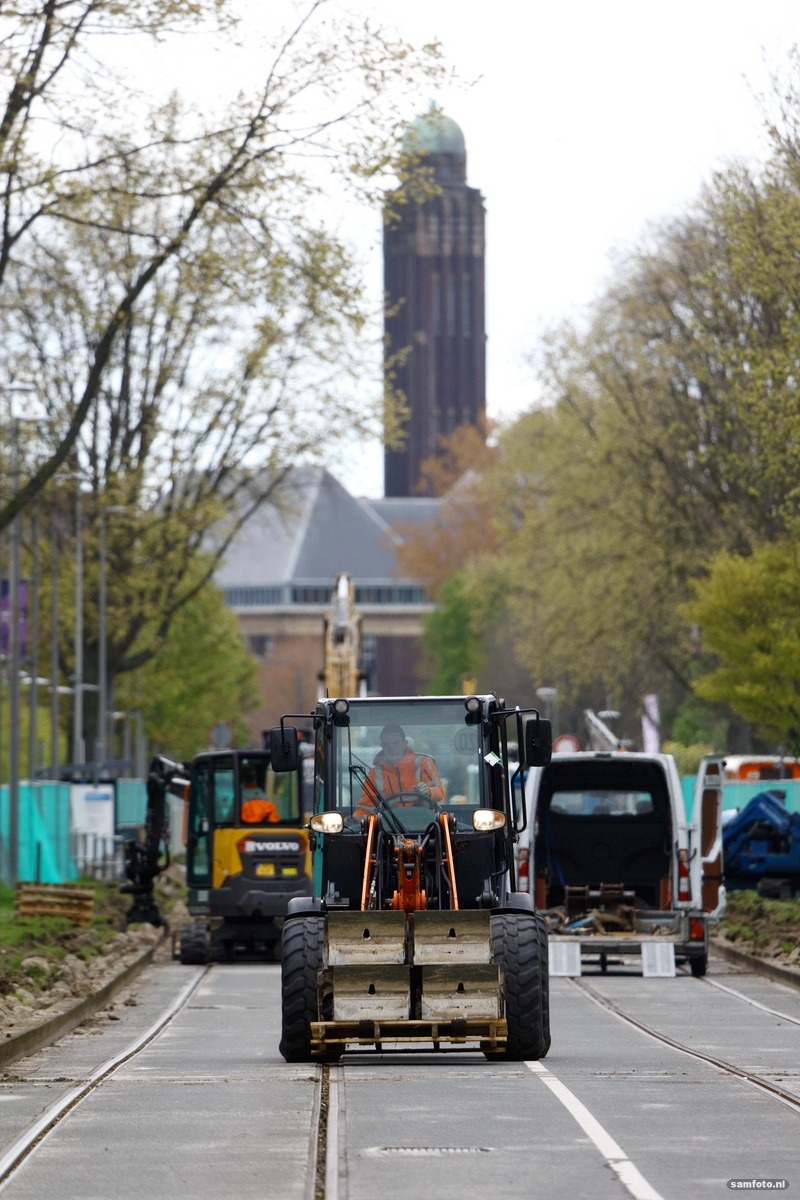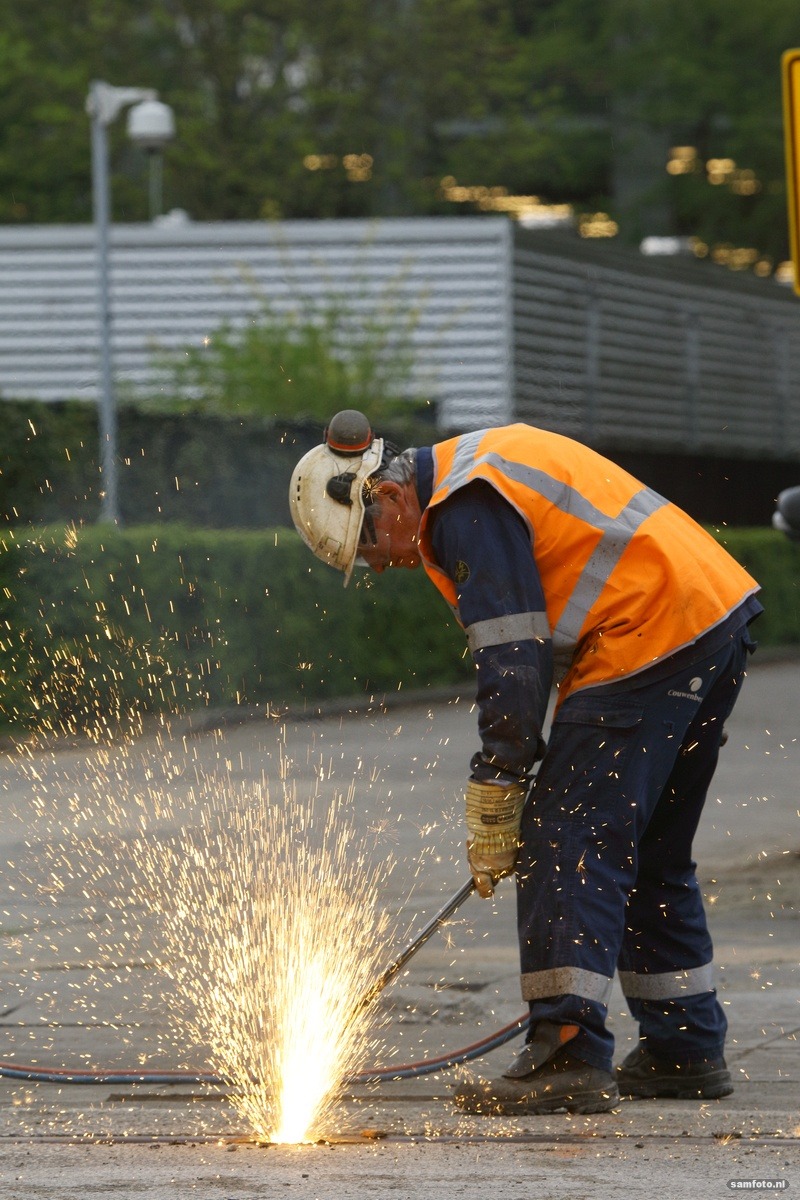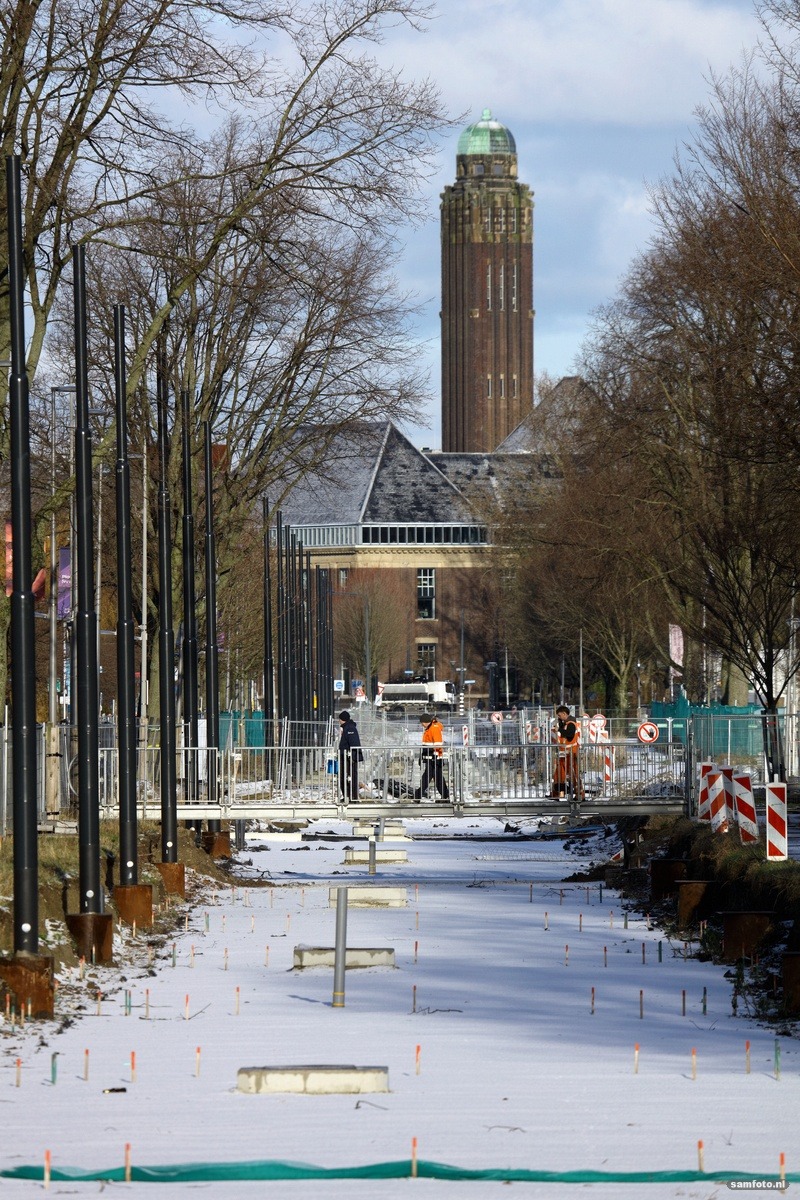At the end of June 2024, concrete is being poured on the tracé of tram line 19. (Photo: Thijs van Reeuwijk)
Who has not seen the board at the lengthy construction site on the Mekelpark: ‘Tram 19 will run here next year’. This year is 20 years since TU Delft gave permission for tram tracks to be laid across campus. So why is there still no tram? A reconstruction of events.
This article in 1 minute
- In 2004, the TU Delft Executive Board agreed to the plan for a tram route along the Mekelweg. It would create a fast connection from Leidschendam to the TU Delft campus.
- As the route ran along various faculties and laboratories, an investigation into vibration and radiation that the trams and the high voltage power system could cause was done in 2005.
- After years of delay – the Sint Sebastiaansbrug bridge had to be made able to support trams – the project group met again in 2021. It then transpired that HTM was planning to use a new type of tram while the research had been done on the old tram.
- The tracks laid in 2014 are now not usable and do not meet the requirements for vibrations and radiation set by TU Delft. The tracks were removed along one kilometre.
- In 2022, TU Delft suggested using a special concrete foundation and a special underground high voltage power cable. One year later, it turned out that the cable did not meet the requirement of TU Delft and the concrete was unusable.
- The plan is that the first new HTM trams will run across TU Delft’ grounds from 07:00 to 19:00 at the end of 2025.
It is the summer of 2014. There is a happy atmosphere at TU Delft. Finally there are rails across the Mekelweg, the main transport artery in TU Delft’s campus area. The tram is to connect Delft Station to TU Delft once and for all, a wish that the then more than 25,000 students had cherished for years. That a tram would run along the Mekelweg can be called a great success for the student associations at TU Delft. A success which they had had to wait for for a very long time. Thirteen years prior to this, in 2001, the student associations ran a campaign for a tram.
The Executive Board originally wanted to hear nothing of the idea. The university administration was of the opinion that the tram should run behind the campus, along the Schoemakerstraat. More than 3,600 students, staff members, professors and the former Rector resisted this option. They thought that the tram should run as close to all the faculties as possible. Only one person objected to the student associations’ plans. That was physics engineer Koets, who worked at TU Delft at the time and issued a warning to TU Delft’s administration. He suspected that trams passing through TU Delft grounds would create vibrations and radiation and cause problems. His warning got buried under the ever increasing protests from the ‘pro’ camp.
An assessment be made of the impact of the trams on the laboratories along the new route on the Mekelweg
A few years after the protests – in 2004 – the administrators took sides with the students and gave their permission for a tram that would go right through the heart of the TU Delft grounds and along different faculties and laboratories. The guarantee was given that the first tram would run by the end of 2011 at the latest. But Koets’ engineering warning from 2001 was not entirely forgotten. The university administration advised that an assessment be made of the impact of the trams on the laboratories along the new route on the Mekelweg. Trams can cause vibrations and high voltage power lines can emit radiation. This could affect or even disrupt research in laboratories.
Vibrations and radiation
Various types of research were carried out in all the faculty buildings along the proposed tram route. According to TU Delft, highly sensitive research was being done at the Faculties of Electrical Engineering, Mathematics and Computer Science, Mechanical Engineering, Applied Sciences, and Civil Engineering and Geosciences. A delegation of TU Delft scientists thus investigated the impact of trams in 2005. In their research they looked at the GTL8 tram, the familiar red and beige trams that plied the The Hague and Delft region. Their conclusion was that with a few minor adjustments, the trams would not cause too much vibration and radiation and would thus have little effect on the laboratories.

The tram route across TU Delft’s grounds is only one section of a longer route. Tram 19 would create a fast connection from Leidschendam to the TU Delft campus, going from Delft Station along Zuidwal and across the Sint Sebastiaansbrug bridge. Since 2014, the body responsible for laying the track has been the Metropolitan Region Rotterdam The Hague (MRDH). MRDH consists of 21 collaborating municipalities (including the municipality of Delft). The coalition started laying the route between Delft station and TU Delft that year.
Adjusted timetable
HTM, the public transport company, was already running tram 19 through Delft and could therefore also run the last leg to TU Delft. Documents requested show that the predecessors of the MRDH (Stadsgewest Haaglanden) had a clear vision of the last leg of tram 19. In a memo dating from 2013, they write that tram 19 should run from Delft station to TU Delft six times an hour from early morning to late at night. They also announced that HTM, starting in 2022, would run new trams and the old red and beige trams would then disappear. A highly significant statement, it turned out later.
Stadsgewest Haaglanden noted in the memo that cutbacks on public transport across the country meant that things would have to be strictly controlled in 2016. The public transport company cut the proposed timetable for tram 19 between Delft Station and TU Delft from six to four times an hour. Further, the tram would only run between 07:00 and 19:00. HTM explained that it needed to run the trams ‘efficiently’ and avoid ‘running empty’ from and to TU Delft. Instead, buses would run in the evenings and weekends. Up to today, this decision has created much dissatisfaction in Delft. HTM has stated that the agreements made in the memo in 2013 were not made definitive in contracts. That said, the agreements still apply now in 2024.

New type of tram
When the Sint Sebastiaansbrug bridge was renovated in 2020 after years of delays and many millions of euros, it looked like everything was on go to lay the tram track. In mid-2021, the project members of MRDH, HTM and TU Delft came together to discuss the progress of the project. The expectation was that it would not be long before the first trams would run to TU Delft. After all, the tracks were already there. HTM opened the meeting with a presentation of the plans for tram 19 between Delft Station and TU Delft. The transport timetable was shown. As announced, the tram would indeed only run four times an hour and only between 07:00 and 19:00. Buses would run the rest of the time and in the weekends. Up to now, no surprises for the meeting attendees.
But the next slide hit the project members of the MRDH and TU Delft hard. The slide showed HTM’s new tram: the Avenio. These new trams have run in The Hague and around Delft since 2015, and HTM said that they would also be used on the route to TU Delft. HTM pointed to the announcement of 2013. While it indeed said that HTM would use new trams as of 2022, TU Delft and the MRDH had not taken this into account. The research into vibrations and radiation that TU Delft had done in 2005 was on the old GTL trams and the two types of tram are not comparable.
‘That means that we have to start from scratch with the new tram. Everything has to be removed. Who will pay for that?’
The old GTL trams weighed 37,000 kilos while the new Avenio ones weigh 50,000 kilos, more than one third more. The weight would create a lot more vibrations on the tracks than what the researchers had anticipated. And it was not only the weight that was a problem. The Avenio trams also emit high voltage electrical radiation while running that could affect sensitive research systems in the laboratories. The TU Delft research from 2005 was based on old data and was no longer applicable. But the tram track between Delft Station and TU Delft was laid and ready. “That means that we have to start from scratch with the new tram. Everything has to be removed. Who will pay for that?” asked a project member aloud. There was no answer.
Unsuitable rails
Not long after this tumultuous meeting in 2021, the decision was taken to shorten the tram route. The tram would not run all the way to ‘Technopolis’ in South Delft as was originally intended. Instead, the last stop would be close to the X sports and culture centre and the Kruithuisweg. That is halfway to the TU Delft area, but still across the Mekelweg. By shortening the tram route, TU Delft believed that there would still be ‘location options for activities that must not be subject to radiation from the trams’ on its grounds. But that area would miss out on a tram. At that point in time, TU Delft and the MRDH were still vague about the exact end point.
The announcement of the new HTM tram meant that the tracks that were laid in 2014 on the TU Delft grounds became redundant. The tram route had been laid for the old HTM trams and no longer met TU Delft’s requirements of avoiding as much vibration and radiation as possible. While no single tram wheel has as yet run along the track, the decision was taken to remove the one kilometre long track on TU Delft’s grounds. Most of the stops that had already been added needed to be removed as well and the height of the platforms needed to be changed.









Costs
The budget for the whole tram route from Leidschendam to TU Delft was estimated at EUR 130 million in 2004. But that money was already used up by 2009 while the Delft section still had to be built. According to insiders, that section cost more than EUR 60 million in the end, for which the Municipality of Delft only coughed up a few millions. The price tag for the renovation of the Sint Sebastiaansbrug bridge was EUR 25 million in the end. And the cash register kept ticking on as the problem with the section to TU Delft was still not solved at the end of 2020.
More than a year later, in the summer of 2023, there was finally some good news
At the beginning of 2022, there was another meeting with TU Delft and the MRDH transport section. TU Delft had an advisory role in the tram project and suggested that a special concrete foundation of two kilometres be built beneath the tracks on its grounds. A special high voltage power cable should also be placed underground. A conservative estimate of the extra costs amounted to about EUR 10 million. The budget for the tram route across TU Delft’s grounds was EUR 53 million, but it looked like it was going to go up to at least EUR 68 million. TU Delft was not intending to pay any of it. The agreement was that TU Delft would not pay more than EUR 4 million towards the entire tram project and its contribution would mostly be in supplying expertise and advice. Pointing to the agreements made with MRDH, TU Delft’s position was that the costs of the latest setback would have to be covered by MRDH and/or HTM.
Wrong high voltage power cable

More than a year later, in the summer of 2023, there was finally some good news. The new high voltage power cable had arrived and the construction company had managed to get the special concrete to Delft. But there were still more setbacks to come. The high voltage power cable did not meet TU Delft’s specifications. ‘Wrong order’, said MRDH. The cable had to go back and a new one was ordered.
The costs of both cables are unknown. This was not the only complication either. The construction company incurred problems when trying to build the new foundation. The concrete that TU Delft had suggested did not work in practice because of its special composition. It also turned out that there were other underground cables in various places on the TU Delft grounds so that no drilling could be done.
In an official letter to the MRDH, TU Delft stated that the setbacks were unacceptable. TU Delft was concerned that these would damage its good reputation. It also said that deploying its own experts for the concrete and cable was more expensive than anticipated and that this is ‘highly undesirable’. That the MRDH’s bill had increased to around EUR 14 million did not seem to affect TU Delft’s position. TU Delft said that construction could only resume after it had checked everything beforehand. It believed that this was the only way to limit delays and ensure that everything would be done in line with its recommendations. TU Delft’s demand was that the first trams would run at the beginning of 2024. At the MRDH office, the employees emailed each other saying ‘more demands, but not more money’. But the MRDH eventually covered the bill as the financial agreements were on paper in black and white. It paid the extra EUR 14 million.
Another new type of tram
It is now 23 years after the student protests that unintentionally triggered the tram problems related to TU Delft’s grounds for years. TU Delft’s decision to have trams run problem-free along the laboratories had major consequences. Apart from the issues of vibrations and radiation for laboratories, the arrival of a new type of tram brought up these issues again.
The current plans are that the first new HTM trams will run across TU Delft’s grounds at the end of 2025. They will run from 07:00 to 19:00 as agreed with the relevant parties to make the line viable for HTM. In any case, the tram tracks will be suitable to carry the new HTM trams.
Another chapter to the ever longer headache story of tram 19
The degree to which the new trams will also suitable to run to TU Delft is not known. HTM has again announced that it will introduce a new type of tram again at the end of this year. It is not known how much vibration and radiation these trams will produce. In a response, TU Delft stated that it takes no responsibility in this. The MRDH says that HTM has to prove that the new trams meet the requirements in terms of vibrations and radiation. This could add yet another chapter to the ever longer headache story of tram 19.
This article was made possible with the help of the Mediafonds Delft.
Adversarial procedure
In compiling this research article, the necessary journalistic steps were carefully followed to ensure the accuracy and completeness of the information. This involved a thorough adversarial procedure for the Metropolitan Region Rotterdam The Hague (MRDH), the Municipality of Delft, the Technical University of Delft (TU Delft), and the The Hague Tram Company (HTM). All these parties have answered questions in advance and were closely involved in the article’s verification process.
The draft article was also presented to them before publication. They thus had the opportunity to read it and give feedback. After their responses to the draft article were received, amendments were made to ensure the accuracy of the final article. All the parties involved also had the opportunity to comment on the final article. This final step in the adversarial procedure ensured that all the parties involved had a voice in the process right through to the end and that their views are represented correctly and fairly.
Accountability for research
In compiling this research article, care was taken to use several different sources so as to sketch as complete and accurate picture of the situation as possible. Discussions were carried out with various people involved, who contributed their information anonymously. These sources, who have direct knowledge of the events and processes described, have passed on valuable understanding and information that are not publicly available through the official communications channels.
Apart from these personal interviews, extensive research was carried out on the documents that were made public under the Open Government Act (Wet Open Overheid, WOO). These documents, which range from official reports and policies to press releases and other types of publicly accessible information, served as an important basis for verifying facts and contextualising the information obtained from the interviews.
Further, research was carried out on archived material to obtain historical context and background information. These entailed reading through previous news articles, official archives and other relevant historical sources. This research was essential to understand the developments and events in a wider time frame and to see how these events unfolded and what effects they have had on the current situation. By combining interviews with anonymous insiders, analysing public documents and delving deeply into archives, an attempt was made to create an accurate and balanced picture in the article as is possible.



Comments are closed.